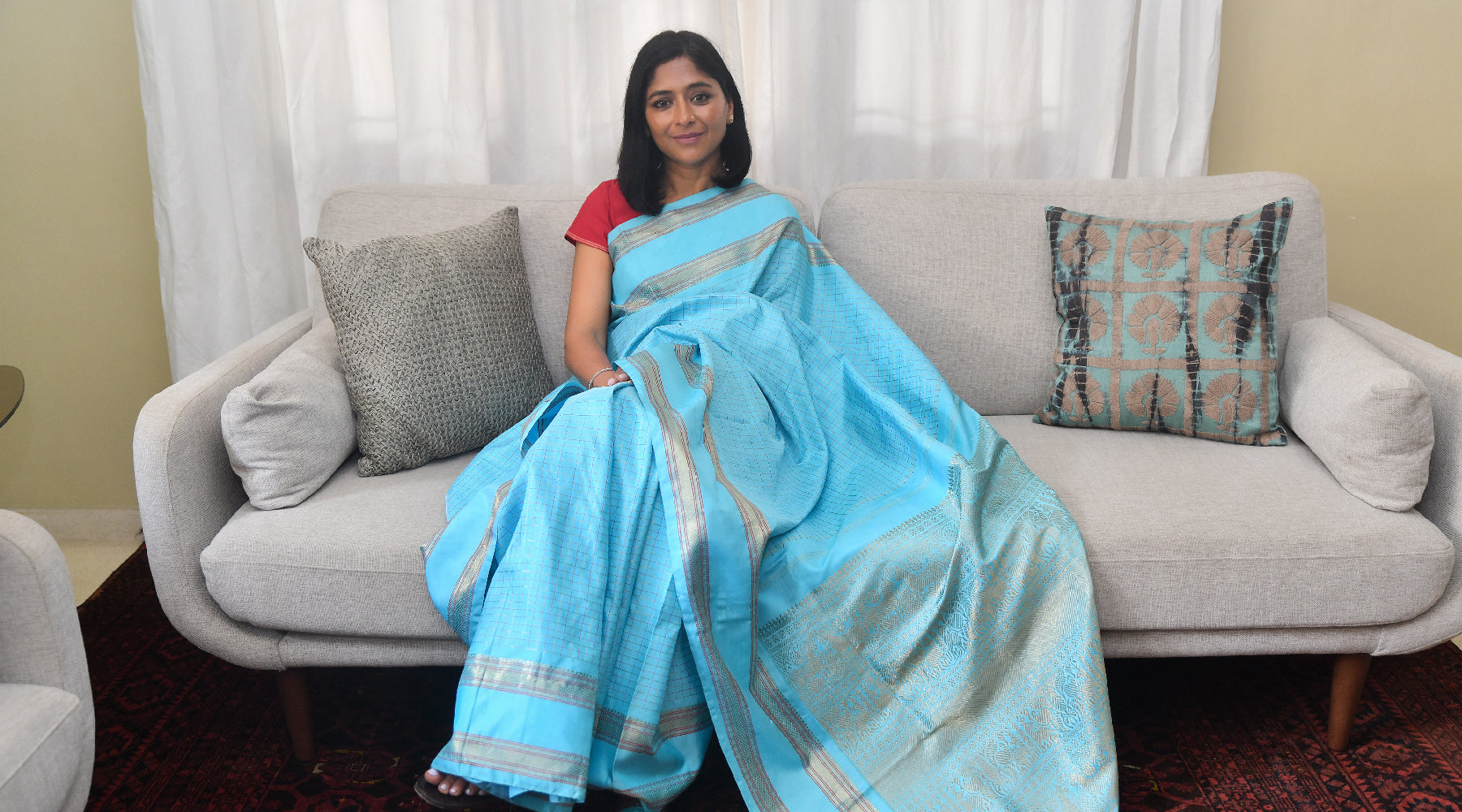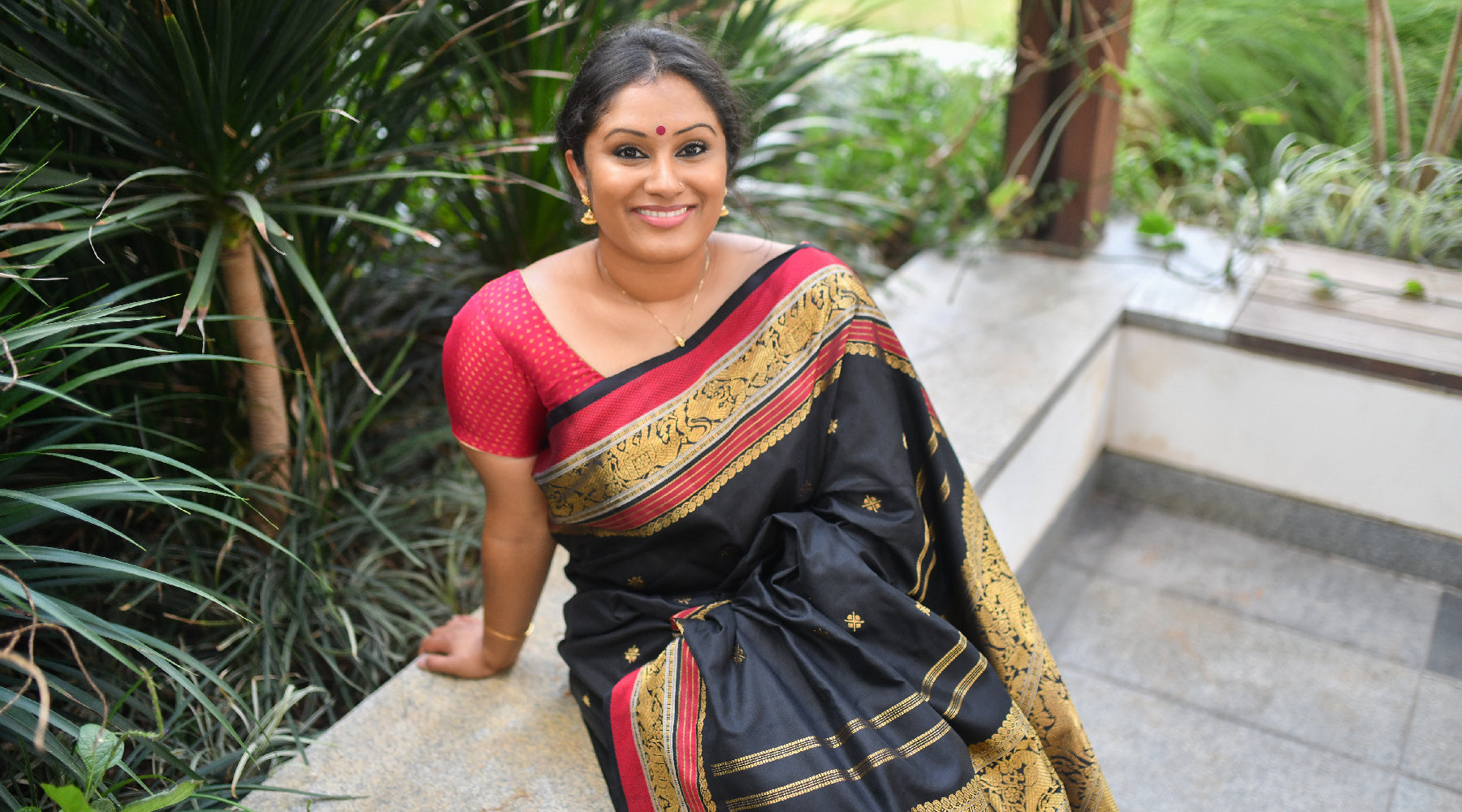KANAKAVALLI VIGNETTES : Radhika Bapat - In Pursuit Of Challenges

Radhika Bapat, Kanakavalli’s July Vignette, is extraordinarily multifaceted. She is a clinical psychologist who has worked at the forefront of this field in India, and is now also running a factory that blends alcohol. An avid reader and writer, she has not only published articles in academic journals, but has written a children’s book published by Pratham in 11 Indian languages and reviewed by the renowned Smithsonian Asian Pacific American Centre. Radhika does not fit into a mould and this in essence has led to her new obsession – Indian textiles and embroidery. As a tribute to her 93-year-old grandmother who has created exquisite embroidered pieces of art, Radhika began travelling around the country to study handloom clusters. She also began to create her own clothes, studying design and textile books while dabbling in embroidery and dyeing techniques. In conversation with Aneesha Bangera of The Kanakavalli Journal, Radhika reflects on how the conversation on mental health in India can be made more meaningful, while also tracing her love for the sari. Taking time out of a busy work and extra-curricular schedule, Radhika has curated a selection of her favourite Kanakavalli kanjivarams that reflect her personality.
In Pursuit of Challenges
As a child, what did you dream of growing up to be?
I had a spectacular childhood and was neither asked, nor ever thought about growing up. I was entertained by a mother and brother who have a Wodehousian sense of humour and a father who is great at PJs (poor jokes). It was not until I was 18 that I started panicking about the future.
Were your ambitions influenced by your upbringing and the work that you saw members of your family doing?
I can attribute the realisation of my ambitions to the degrees of freedom that I enjoyed. Almost all the women in my life were dynamic persons, and all the men in my life supported, encouraged and treated me as an equal. I was academically competent and financially stable. As a result, my self-esteem has generally been on the upside. It would be absolutely tragic if someone in my position were not to take advantage of this luck. I was ambitious but I didn't have any specific purpose.
Having worked at the forefront of the field of clinical psychology in India, what are your thoughts on the conversation around mental health in the country? Do you think this conversation needs to change, and if so, then how?
To begin with—I am thrilled that a conversation around mental health is happening at all. I see celebrities talking freely about their struggles, and an openness especially with young adults who are willing to talk about problems. There is a greater acceptance for outliers. In my opinion, there are three things that need to happen in the immediate future: - The quality of medical journalism needs to improve in form and content. Journalists need to be thoroughly trained in research methods and “proper” reporting. - We need to discuss Time-Use in India. A 48-hour/6-day work week alongside 12 hours of travel time a week affects families, leisure and mental health. - We need to be inclusive and make diversity a part of life -sensitise school kids via play to be inclusive of differences.
As a writer, your work has spanned scientific journals as well as children's literature. Tell us a little about your process. Do you think writing helps you deepen your practice in the field of psychology?
Compared to my notes to myself, I have only published a tiny fraction of my works. As a perfectionist, one suffers from editing and re-writing something over and over again, until it is “fit” to be told. Luckily, my blog is a result of my partner pushing me to click “publish” before I can edit what I wrote. Recently, I have been writing short pieces for myself that I share with my inner circle of friends, about how one can make one’s own clothes in India without spending a lot of money, and without having to go through middlemen to source materials. More than writing, I think reading is what deepens my practice. I am a voracious reader and I read across a wide variety of subjects. I subscribe to Lapham’s Quarterly, a literary magazine that covers a topic each month by curating texts by some of the world’s most well-known writers. For those who don’t have time to read entire novels, this quarterly is wonderful. I have been reading more consistently over the last year, and the next book I’m hoping to read is Friedrich Nietzsche’s ‘Thus Spoke Zarathustra’.

Above (left to right): Radhika's PhD research thesis; Her book for children titled 'Takloo The Little Salt Tycoon' published by Pratham Books
Over the last two years, you have taken on different roles in completely different areas of work. Could you tell us a little bit about how this shift happened and what this has meant for you?
I studied from the age of 3 to 37. I did my BA, MA, Mphil and PhD. I would have been banished from home if I took up a post-doc position. I suffer from being unable to sit still and I know no moderation. A good way to engage me is to challenge me. A few years ago, I was offered the opportunity to run the family factory that blends alcohol. It was exciting in an “I don't know what to expect” sort of way. In terms of the numbers, I could fail miserably, be mediocre or succeed. But I get to learn new skill sets and can represent myself in an industry that has almost all men at its forefront. My parents, who are my mentors, were well aware that there is a “cost of learning curve” and were willing to risk it with me. The idea is to recover emotionally, look up and walk forward, after you make your mistakes.

Is there a single theme or idea that you find yourself returning to in all that you do?
Whatever the kind of work, the single theme or idea that I return to has been to never underestimate the role of support systems in my own success. I have a partner who has a PhD and used to teach, but put his career on hold to support mine. How many women can say that their husbands put their careers on hold for them? Aren’t I lucky? My “inner-circle” of family and friends have logistically supported me through and through.
Do you see a conflict between your work in the sciences and what you do with crafts, i.e what people typically term ‘creative’ and ‘non-creative’?
In my studies on neuro-rehabilitation with Professor Uday Athavankar of IIT Bombay’s Industrial Design Centre, one of the things we realised was that when course material is aesthetically presented, learning happens faster. This means that if I’m reading a text with beautiful visuals, my learning curve is less steep than if I’m reading from a very cluttered page. Visual communication, I learnt, is extremely important from a neurological standpoint. Therefore, I have never really thought of my more typically ‘creative’ work as very different from the rest of the work I do. It all comes together quite seamlessly. I think we have just created these labels and demarcations in our heads.

Above (left to right): Radhika signing the 'Wall of PhDs' at Leiden University; Lilies embroidered by Radhika; An image captured on Radhika's trip to the West Bengal handloom clusters
What are the ways in which you disconnect from your work?
Leisure for me starts to become an obsession but I am unable to switch-off – I can only switch over! I started taking an interest in Indian textiles, sustainable fashion, revival of old motifs and patterns, and teaching myself stitching, as something to help me disconnect. This consumed me and I read all that I could get my hands on. I have a select collection of handloom stoles, shawls, jewellery, sarees and fabrics that I acquired directly from the source, each accompanied by a 200-400 worded note on how long it took to make, where it is from, who made it, etc. I got someone to work with me to teach me zari and zardosi embroidery and landed up creating a collection of clothes made from the best linen, cotton (not BT cotton), or ahimsa silk along with the artisans’ help. I stay up at night and study—I enjoy browsing through Japanese design books and museum collections. While this disconnects me from my work, it’s an absolute disaster in terms of needing to “switch-off”.
In a sense, through your exploration of textiles, embroidery and handloom, you are continuing your grandmother's legacy. Tell us a little bit about this journey from watching your seamstress grandmother as a child, to travelling around the country to study handloom clusters?
My aaji (grandmother) who is now 93 has done prolific work in embroidery. She saw her family through adversity by sewing. She tells me tales of how she procured magazines such as ‘Woman and Home’ and adventures of how she got hold of Japanese and English Jacobian, Crewel and Tudor designs. She would get her JP Coats threads from Matunga and Khodadad Circle (Dadar). I have two letters which I recently found while cleaning up aaji’s cupboard from Mrs. Krishna Raj Kapoor and Mrs. Ritu Nanda praising the embroidery that she has done for them and the film industry. We always knew this, but it was nice to find some written evidence! The letters were probably written to help her raise the funds to do more work in the 1960’s and 70’s. My childhood memories at aaji’s tiny home included sitting on the floor with the soothing “khat-khat-khat-khat” sound of the imported Singer Machine that her father had gifted her, late into the night. If she didn’t find an exact shade, she dyed the threads herself. Everything was soft. Aaji was soft, the cloth and the threads were all soft. I was in heaven! Travelling around the country to start my study of handloom clusters, and working on embroidery and dyeing of my own was mainly a way to be able to hold an engaging conversation with my aaji. She lost her eye-sight five years ago and this was my way of being able to narrate to her my sights. It also helps me to dare myself to fly often. I am convinced that I have flying phobia.

Above (left to right): Radhika, her husband and their son with their American family; Radhika with her beloved aaji (grandmother); With her parents, brother and family
How has your love for the sari evolved over the years? Tell us a little bit about your discovery of the kanjivaram.
My introduction to saris was my mother. She loved and continues to love wearing them. My own fascination for the Nivi drape and the 9-yard sari happened at around the age of 18. My friend and artist Abir Patwardhan needed a model for his Ahilyabai Holkar installation and I wore a 9-yard sari for it. This sort of flattery naturally affected me. Since then, these form part of my collections. I don’t buy saris unless I find something distinctive about them. Nalli and Angadi were where I would go for saris if there was any upcoming occasion, apart from Tilak Smarak and Sonal Hall in Pune, which frequently hold exhibitions. At Kanakavalli I chose pieces that I knew stood out.
How would you define beauty and tradition?
A beautiful person (to me) is someone with whom I can have an engaging conversation, someone sorted, open, someone who loves life and has a solid sense of humour. Their smile is equally important. It’s hard for me to find someone beautiful, if they take themselves too seriously or if they have fixed, inflexible, rigid belief systems. For this reason, I enjoy the artist Fernando Botero and his works. He depicts voluptuous people and exaggerated figures that I enjoy. Tradition, to me, is the blind transmission of customs or beliefs from generation to generation and I believe that in order to evolve we must question, challenge and reconstruct it.


Above: Radhika's three favourite Botero works - (left to right) Lovers (1969), The Dancers (1987), L'Odalisque (1998)
What is the story behind the Kanakavalli kanjivaram you have chosen to wear for Vignettes?
The sari that I chose to wear, I am given to understand, was created from motifs that were revived from a much, much older sari. Classical motifs of birds and beasts that you don’t usually find all in one sari were present in this one—the swan (hamsa), the parrot (kili), the elephant (yanai), the lion (simha), peacocks (mayil), the deer (maan) and my favourite—the mythical Yaali (part-lion, part griffin or part-elephant, or part-horse). How could I not buy a sari that is so symbolic and so varied? If I ever buy another kanjivaram, it had better compete with this one in beauty and singularity!

Radhika is wearing an elegant kanjivaram sari from our 'Vault' collective in grey shot with black with thuthripoo checks in orange and gold enclosing lion, horse, elephant, deer and yazhi motifs in gold zari. The border has floral, diamond and geometric motifs in zari, with bands and chevron patterns in orange. The pallu is woven in the 'adai' technique, featuring a diamond band edged by yazhi, horse and geometric bands in gold zari.
- Radhika Bapat, in conversation with Aneesha Bangera, photography by Raghuram Vedant
View Radhika's guest curation here



